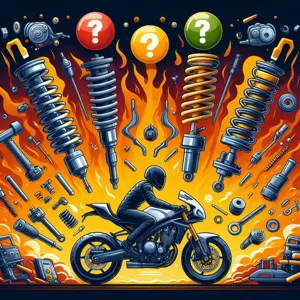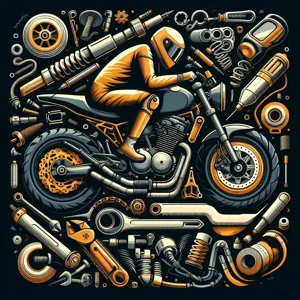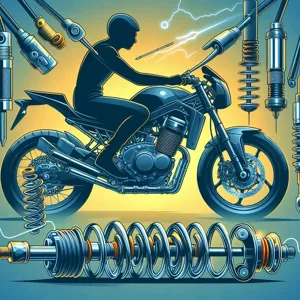When it comes to the exhilarating world of motorbiking, the thrill of the ride often hinges on one crucial element: suspension.
It’s the unsung hero that transforms a standard journey into a dynamic adventure, absorbing bumps and delivering a smooth, controlled experience on any terrain. Whether you’re a seasoned rider carving through mountain passes, a casual commuter navigating city streets, or an off-road enthusiast tackling rugged trails, understanding the nuances of motorbike suspension is key to mastering your ride. In this comprehensive guide, we’ll delve into the various types of suspension systems, their impact on handling and comfort, and how to choose the perfect setup that aligns with your riding style and preferences. Get ready to elevate your motorbiking experience as we help you navigate the intricate world of suspension tuning and optimization!
1. Understanding Motorbike Suspension Basics

Before diving into the specifics of choosing the perfect motorbike suspension for your riding style, it’s essential to grasp the fundamental principles of how suspension systems function. At its core, a motorbike suspension is designed to enhance your riding experience by balancing comfort, control, and performance. It works by absorbing the shocks and vibrations from the road, ensuring that both you and your bike can navigate various terrains with ease.
Motorbike suspension typically consists of two main components: the front forks and the rear shock absorber. The front forks are responsible for absorbing bumps and dips in the road while providing steering precision. They play a critical role in maintaining stability and handling during turns and stops. Conversely, the rear shock absorber manages the bike’s weight distribution and keeps the rear wheel in contact with the ground, which is vital for traction and acceleration.
Understanding the difference between the two types of suspension systems—traditional and modern—is also crucial. Traditional suspensions use a simpler design with coil springs and dampers, offering basic performance. In contrast, modern suspensions, often featuring adjustable components, allow riders to fine-tune their setup based on personal preferences and riding conditions. This adjustability can range from preload settings to compression and rebound damping, offering a customized experience that can significantly enhance your ride.
Additionally, the type of motorbike you ride will influence your suspension choice. Cruiser bikes, sport bikes, and touring bikes all have different suspension needs based on their intended use. For example, sport bikes typically require stiffer suspension for better handling at high speeds, while cruisers may benefit from a softer setup for a smoother, more comfortable ride on long journeys.
Ultimately, a solid understanding of motorbike suspension basics will empower you to make informed decisions when selecting the right suspension setup for your unique riding style. By knowing how each component contributes to your overall experience, you can enhance your bike’s performance and enjoy every twist and turn of the road ahead.
2. The Importance of Suspension in Riding Performance
When it comes to mastering the ride, the importance of suspension in riding performance cannot be overstated. Suspension serves as the crucial link between the motorcycle and the road, absorbing shocks and impacts while maintaining tire contact for optimal traction. A well-tuned suspension system not only enhances the overall comfort of your ride but also significantly influences handling, stability, and control.
Imagine navigating a winding mountain road; it’s the suspension that allows your bike to smoothly glide over bumps and dips, allowing you to maintain your line without losing confidence. Conversely, poor suspension can lead to a jarring ride, resulting in fatigue, reduced maneuverability, and an increased risk of losing control. Whether you’re a casual commuter or a thrill-seeking racer, the right suspension setup can elevate your riding experience, transforming every journey into a seamless blend of performance and pleasure.
Moreover, the type of riding you engage in—be it touring, off-roading, or sport riding—demands specific suspension characteristics. A touring bike may benefit from a plush, forgiving setup to soak up miles of highway, while a sportbike requires a stiffer, more responsive suspension for sharp cornering and high-speed stability. Understanding these nuances is essential in ensuring that your bike is not just an extension of yourself but a finely tuned machine that complements your riding style.
In essence, investing time to comprehend the significance of suspension will pay dividends in how you experience each ride. A well-crafted suspension setup enhances your connection with the motorcycle, giving you the confidence to push boundaries while ensuring a smooth, exhilarating ride. So, as you embark on your journey to mastering the ride, remember: the right suspension is not just an accessory; it’s an integral component of your performance and enjoyment on two wheels.
3. Different Types of Suspension Systems: An Overview

When it comes to selecting the right motorbike suspension, understanding the various types of suspension systems available is essential for tailoring your riding experience. Each system offers distinct characteristics that can significantly influence both performance and comfort, catering to different riding styles and terrains.
**1. Conventional Forks**: This is the most common type of front suspension found on motorcycles, featuring a pair of telescopic forks. They provide decent handling and comfort for everyday riding. However, they can struggle with heavy impacts, particularly during aggressive cornering or off-road scenarios.
**2. Inverted Forks**: Also known as upside-down forks, these have the larger diameter tubes at the top and the smaller tubes at the bottom. This design not only enhances stiffness and improves handling but also reduces weight, making them a popular choice for sport and performance bikes. Riders can expect better feedback from the road, which is crucial for high-speed maneuvers.
**3. Monoshock Suspension**: Found on many modern bikes, monoshock systems use a single shock absorber at the rear, providing superior balance and weight distribution. This setup is particularly beneficial for sport and adventure touring bikes, offering excellent handling while maintaining comfort over various terrains. Adjustable settings can fine-tune the ride according to the rider’s preference and load.
**4. Dual Shock Suspension**: Traditional in design, this system utilizes two shocks at the rear and offers a plush ride, especially suited for cruising and touring motorcycles. While they can compromise performance in aggressive riding situations, their simplicity and reliability make them a favorite for riders who prioritize comfort on long journeys.
**5. Air Suspension**: This innovative system utilizes air pressure to adjust the ride height and stiffness of the bike’s suspension. Air suspension allows for a customizable ride quality and is particularly useful for riders who frequently switch between solo and two-up riding. However, it requires more maintenance and understanding of air pressure settings.
**6. Progressive Suspension**: This system features springs that compress at varying rates, offering a soft ride during initial travel while stiffening up for harder impacts. It’s an excellent choice for riders seeking versatility, as it can handle both city streets and rugged terrains without compromising comfort or control.
Each type of suspension system has its strengths and weaknesses, and the best choice ultimately depends on your riding style, the type of motorcycle you own, and the conditions in which you ride. By familiarizing yourself with these different systems, you can make an informed decision that enhances your overall riding experience, ensuring that every journey is as smooth and enjoyable as possible.
4. How Suspension Affects Your Riding Style
When it comes to mastering the ride, understanding how suspension affects your riding style is crucial. The suspension system of a motorbike plays a vital role in how it handles the road, interacts with various terrains, and responds to your riding techniques. Essentially, it serves as the bike’s intermediary between you and the road, absorbing shocks and maintaining contact with the surface beneath you.
For riders who enjoy aggressive cornering and high-speed cruising, a sport-oriented suspension setup with a stiffer configuration can offer the responsiveness and precision needed to navigate turns with confidence. This type of suspension typically features adjustable components, allowing you to dial in the compression and rebound settings based on your weight and riding preferences, ensuring that your bike feels like an extension of your body.
On the other hand, if your style leans towards leisurely rides on uneven backroads or off-road adventures, a softer suspension can provide the comfort and stability you crave. A well-balanced, plush suspension system absorbs bumps and dips, offering a smooth ride that allows you to take in the scenery without feeling every jolt of the terrain. This setup often includes longer travel and is designed to keep your wheels planted firmly, enhancing traction even on loose surfaces.
Moreover, the type of suspension—whether it’s traditional telescopic forks, monoshock systems, or more advanced options like air or progressive suspension—will significantly influence your riding experience. Each design has its unique characteristics that cater to different riding styles, so it’s essential to consider what best aligns with your preferences.
In summary, the suspension system is not just a technical component of your motorbike; it is a pivotal factor that shapes how you interact with your environment while riding. By understanding its effects on your riding style, you can make more informed decisions when it comes to tuning or upgrading your suspension, ultimately enhancing your overall riding experience. Whether you’re carving up the racetrack or cruising down a country lane, the right suspension setup can transform your journey into a truly exhilarating adventure.
5. Riding Styles Explained: Sport, Cruiser, Touring, and Off-Road

When it comes to motorbiking, understanding the nuances of different riding styles is crucial for selecting the right suspension that enhances your experience on the road, trail, or track. Each riding style has its distinct characteristics, demands, and preferences, influencing the type of suspension system that will best suit your needs. Let’s explore the four primary riding styles: Sport, Cruiser, Touring, and Off-Road.
**Sport Riding:**
Sport riding is all about speed, agility, and precision. Riders in this category crave the adrenaline rush that comes with sharp turns and high-speed maneuvers. A sportbike’s suspension is typically stiffer, designed to handle rapid weight shifts and provide maximum feedback from the road. If you find yourself leaning into corners, pushing the limits on the racetrack, or navigating twisty mountain roads, look for a fully adjustable suspension system. This allows you to fine-tune the compression and rebound settings to suit your aggressive riding style, ensuring optimal grip and control.
**Cruiser Riding:**
Cruisers embody a laid-back approach to motorbiking, focusing on comfort and a relaxed riding position. With their low-slung frames and wider handlebars, cruisers are perfect for leisurely rides along scenic highways. The suspension on these bikes tends to be softer, providing a smooth, cushioned feel over long distances and pothole-riddled roads. When choosing a cruiser, consider a suspension system that emphasizes comfort, such as a progressive spring setup, which allows for a plush ride while still offering enough support for occasional spirited rides.
**Touring Riding:**
For those who prioritize long-distance journeys, touring bikes are equipped with features that enhance comfort and convenience. These bikes often come with advanced suspension systems that can handle varying loads, as touring riders frequently carry luggage and passengers. Look for a suspension that offers adjustable preload and damping settings, allowing you to adapt the ride to different conditions and weights. Comfort is key here, as you’ll want a suspension that minimizes fatigue during those marathon rides across the country.
**Off-Road Riding:**
Adventure awaits for those who venture off the beaten path. Off-road riding demands robust suspension systems designed to absorb the shocks from uneven terrain, rocks, and roots. These bikes typically feature longer travel suspension with a more rugged construction to handle the rigors of trail riding. If you’re an off-road enthusiast, prioritize a suspension that offers high ground clearance and adjustable settings, allowing you to tackle everything from sandy trails to muddy paths with confidence.
By understanding the distinct needs of each riding style, you can make an informed choice about the suspension that will enhance your motorcycling experience. Whether you’re tearing up the asphalt, cruising down the highway, exploring new landscapes, or hitting the trails, the right suspension can transform your ride, making every journey more enjoyable.
6. Key Factors to Consider When Choosing Suspension
When it comes to selecting the ideal suspension for your motorbike, understanding the key factors that influence performance is crucial. The right suspension setup can enhance your riding experience, ensuring you enjoy a smooth ride while maintaining control, comfort, and safety. Here are some essential elements to consider:
**1. Riding Style:** Your personal riding style is perhaps the most significant factor in suspension selection. Are you an aggressive rider who loves tackling rugged terrains, or do you prefer a more leisurely cruise on smooth highways? Off-road riders often benefit from stiffer suspensions that can absorb the shock of bumps and jumps, while street riders may prioritize comfort and smooth handling. Tailoring your suspension to your riding habits will enhance your overall experience.
**2. Type of Terrain:** Consider the surfaces you’ll typically encounter. If your adventures take you through rocky trails, pothole-ridden streets, or racetracks, your suspension must be equipped to handle these challenges. Different terrains demand specific suspension characteristics, such as increased travel for off-road conditions or firmer settings for track racing. Assessing the terrain will help you choose a suspension that maximizes performance and durability.
**3. Weight and Load Capacity:** The weight of your bike, as well as the load you’ll be carrying, significantly impacts the suspension’s performance. Heavier riders or those who frequently carry passengers or luggage will require a suspension that can handle the extra weight without compromising handling or comfort. Look for adjustable options that can be tuned to accommodate varying loads, ensuring optimal ride quality regardless of your setup.
**4. Adjustable Features:** Opting for a suspension system with adjustable features allows you to customize the setup to fit your preferences and riding conditions. Look for options that enable you to adjust compression, rebound, and preload settings. Having the ability to fine-tune these aspects means you can adapt your bike to different scenarios, whether you’re hitting the trails or cruising down the highway.
**5. Brand Reputation and Reviews:** Not all suspension systems are created equal. Researching reputable brands and reading customer reviews can provide valuable insights into the reliability and performance of various products. Established brands often invest in quality materials and innovative technology, ensuring you receive a suspension that stands the test of time and enhances your riding experience.
**6. Budget:** Finally, consider your budget. While it may be tempting to opt for the cheapest option available, remember that quality suspension plays a critical role in your riding safety and enjoyment. Investing in a reliable suspension system may save you money in the long run by reducing wear and tear on your bike and improving your overall performance. Determine a budget that allows for quality without compromising essential features.
By keeping these factors in mind, you’ll be well-equipped to choose a suspension that complements your riding style and preferences, ensuring every ride is a thrilling and comfortable experience.
7. Custom vs. Stock Suspension: What’s Right for You?

When it comes to motorbike suspension, one of the most pivotal decisions you’ll face is whether to stick with stock options or invest in a custom setup. Each choice carries its own set of advantages and considerations that can significantly impact your riding experience.
**Stock Suspension** is designed to meet a broad range of riding styles and conditions. It’s typically built to balance comfort and performance, making it suitable for everyday use. If you’re a casual rider who enjoys weekend jaunts or commuting without pushing the limits, stock suspension might be just fine. It offers reliability and ease of maintenance, allowing you to hit the road with confidence without the need for specialized knowledge or tools. Plus, it often comes at a lower initial cost, which is a significant factor for new riders or those on a budget.
On the other hand, **Custom Suspension** opens the door to a world tailored specifically to your needs. If you are serious about performance—whether you’re hitting the track, tackling off-road trails, or simply seeking a more responsive ride—investing in a custom suspension setup can make a world of difference. Custom options allow you to adjust the preload, compression, and rebound settings based on your weight, riding style, and the types of terrain you encounter. This level of personalization can enhance stability and comfort, providing a smoother ride even on the most challenging roads.
However, this tailored experience does come with a few considerations. Custom suspensions can be significantly more expensive, and they often require a deeper understanding of mechanics and regular adjustments to maintain optimal performance. Additionally, finding the right suspension specialist is crucial; the wrong setup could lead to handling issues or an uncomfortable ride.
Ultimately, the choice between custom and stock suspension boils down to your riding style, experience level, and budget. For those who crave precision and performance, custom options are worth exploring; however, if you’re looking for hassle-free riding with decent performance, stock suspension could be your best bet. Take the time to evaluate your needs and preferences, and you’ll be on the right track to finding the perfect suspension setup that enhances your riding experience.
8. Understanding Suspension Adjustments: Compression, Rebound, and Preload
When it comes to mastering your ride, understanding the intricacies of suspension adjustments is crucial for tailoring your motorbike to your specific riding style and conditions. Three key components of motorbike suspension adjustments are compression, rebound, and preload, each playing a vital role in how your bike handles on the road or track.
**Compression** refers to how the suspension absorbs impact when hitting bumps or rough terrain. Proper compression settings will help your bike maintain control and stability, allowing it to soak up the shocks from uneven surfaces. If your compression is too stiff, you might feel every bump as a jolt, leading to a jarring ride. Conversely, if it’s too soft, your bike may bottom out, compromising safety and performance. Adjusting compression settings can help you find that sweet spot, giving you a smoother, more comfortable ride while enhancing traction and cornering ability.
**Rebound** is the counterpart to compression, dictating how quickly the suspension returns to its neutral position after being compressed. Think of it as the suspension’s ability to bounce back after being pushed down. Proper rebound adjustment is essential for maintaining stability during a ride; if your rebound is too fast, the bike can feel bouncy and unpredictable, while too slow a rebound can cause the bike to feel sluggish and unresponsive. Finding the right rebound setting enhances your bike’s handling and helps keep your tires in contact with the road, improving both safety and performance.
Finally, **preload** refers to the initial tension placed on the springs of your suspension. Adjusting preload affects the bike’s ride height and can significantly impact how your bike squats during acceleration or braking. A higher preload will raise the bike, increasing cornering clearance and preventing bottoming out during aggressive riding. Meanwhile, a lower preload can provide a softer ride, making it ideal for leisurely cruising or touring. Finding the right preload setting allows you to achieve the perfect balance between comfort and performance, tailored to your riding preferences.
By understanding how to adjust compression, rebound, and preload, you can fine-tune your motorbike’s suspension to match your unique riding style. Whether you’re tackling twisty mountain roads, navigating city traffic, or cruising down the highway, mastering these adjustments will not only enhance your riding experience but also ensure that you have the confidence and control to handle any situation that comes your way. So take the time to experiment with these settings to discover what works best for you, and enjoy the ride like never before!
9. The Role of Weight and Height in Suspension Selection
When it comes to selecting the perfect motorbike suspension, understanding the crucial role of your weight and height cannot be overstated. These two factors significantly influence how your bike handles and performs, making it essential to consider them carefully during your suspension selection process.
Firstly, your weight directly impacts the amount of sag in the suspension system. Sag is the distance the suspension compresses under your weight and is critical for achieving optimal ride quality and handling. If you’re lighter than average, you might experience a stiffer ride and less traction, as the suspension won’t compress enough to absorb bumps and irregularities in the road. Conversely, heavier riders may find that their bike sags too much, leading to a lack of control and stability, especially during sharp turns or aggressive riding.
Height also plays a pivotal role in suspension selection, mainly because it affects your center of gravity and overall balance on the bike. Taller riders may need to adjust the suspension to ensure they can plant their feet firmly on the ground when stopped, while shorter riders might require a setup that lowers the seat height for better accessibility and confidence. Moreover, the geometry of the bike can change based on rider height, which in turn affects handling dynamics.
To achieve the best riding experience, manufacturers often provide guidelines on suspension settings based on weight and height. It’s advisable to consult these specifications or work with a suspension specialist who can help customize your setup. By taking your weight and height into account, you can ensure that your motorbike not only feels comfortable but also performs at its best, allowing you to master every ride with confidence and ease.
10. Popular Suspension Brands and Their Offerings
When it comes to motorbike suspension, selecting the right brand can significantly impact your riding experience. Several manufacturers have established themselves as leaders in the industry, each offering unique technologies and products tailored to different styles of riding. Here’s a closer look at some popular suspension brands and what they bring to the table:
**1. Ohlins:** Renowned for their premium quality and performance, Ohlins specializes in high-end suspension systems that are often found on racing bikes and premium motorcycles. Their products, such as the TTX series, feature advanced technology designed to enhance stability and handling, making them a favorite among professional riders and enthusiasts alike.
**2. Showa:** A staple in the motorcycle suspension world, Showa produces a wide range of products that cater to both street and off-road bikes. Their innovative designs, like the Big Piston Fork, offer improved damping characteristics and greater control, ensuring a smooth ride across various terrains.
**3. KYB (Kayaba):** Known for their reliability and performance, KYB is a top choice for both motocross and sportbike riders. Their suspension systems are designed to absorb bumps effectively while providing responsive handling, making them ideal for those who push their bikes to the limit.
**4. Fox Racing Shox:** If you’re into off-road riding, Fox is a brand you can’t overlook. They offer a variety of suspension products that excel in rugged terrains, featuring technology that allows for easy adjustments on the fly. Their Float series is particularly popular among trail riders for its lightweight design and exceptional performance.
**5. Progressive Suspension:** For riders looking for a balance between comfort and performance, Progressive Suspension delivers. They offer a range of aftermarket shocks and forks that enhance the riding experience without sacrificing ride quality. Their products are ideal for touring and cruiser bikes, providing a plush, comfortable ride even on long journeys.
**6. Bitubo:** An Italian brand gaining traction in the motorbike community, Bitubo offers high-performance suspension solutions tailored to various riding styles. Their adjustable shocks and forks provide riders with the ability to fine-tune their setup for optimal performance, making them an excellent choice for those who enjoy a personalized ride.
Whether you’re a casual rider or a hardcore enthusiast, understanding the offerings of these popular suspension brands can help you make an informed decision. Each manufacturer aims to provide products that not only improve handling and comfort but also elevate your overall riding experience. By choosing the right suspension, you can master the ride and truly enjoy every moment on the road or trail.
11. Setting Up Your Suspension for Optimal Performance
Setting up your suspension for optimal performance is crucial for both safety and enjoyment on the road or trail. The right suspension setup can dramatically enhance your riding experience, providing you with better control, improved handling, and increased comfort, no matter your style of riding.
Begin by understanding the key components of your suspension system: the springs, dampers, and preload adjustments. Each of these elements plays a vital role in how your motorbike responds to different terrains and conditions. For instance, heavier riders may need stiffer springs to prevent bottoming out, while lighter riders might benefit from softer springs that allow for better absorption of bumps and imperfections.
Once you’ve selected the appropriate springs, focus on adjusting the preload. This adjustment determines how much weight the springs need to support before they begin to compress. A good rule of thumb is to set the sag— the amount the bike compresses under your weight— to about 25-30% of the total travel of the suspension. This ensures that your bike maintains optimal traction and stability while allowing for maximum travel when hitting bumps or dips.
Next, fine-tune your damping settings, which control how quickly your suspension compresses and rebounds. Start with the manufacturer’s recommended settings and make small adjustments based on your riding style and the terrain. If you often ride on rough trails, you might want to increase compression damping for better control. Conversely, if you’re cruising on smooth roads, a softer setting can provide a more comfortable ride.
Finally, don’t hesitate to seek the expertise of a professional suspension tuner, especially if you’re unsure about the adjustments or if you’re looking to get the most out of your bike. They can provide invaluable insights tailored to your specific needs, ensuring that you achieve the perfect setup for your riding style.
By dedicating time to properly set up your suspension, you’ll not only enhance your bike’s performance but also enjoy a smoother, safer ride that keeps you coming back for more adventures on two wheels.
12. Common Suspension Mistakes to Avoid
When it comes to optimizing your motorbike’s performance, the suspension system plays a critical role in ensuring a smooth and safe ride. However, many riders unknowingly make common suspension mistakes that can compromise their riding experience and even jeopardize their safety. Here are some pitfalls to avoid as you master the art of bike suspension.
**1. Neglecting Regular Maintenance:** One of the biggest mistakes riders make is overlooking the importance of regular suspension maintenance. Just like any other mechanical component, your suspension requires periodic checks and adjustments. Failing to inspect seals for leaks, monitor oil levels, or replace worn-out parts can lead to decreased performance and increased wear on other bike components.
**2. Ignoring Manufacturer Specifications:** Every motorbike is designed with specific suspension settings tailored to its intended use. Many riders make the mistake of arbitrarily changing the suspension settings without consulting the manufacturer’s guidelines. This can lead to suboptimal performance, affecting handling, comfort, and safety. Always refer to your owner’s manual for recommended sag settings and adjustments based on your weight and riding style.
**3. Overlooking Rider Weight and Gear:** A common misconception is that one-size-fits-all when it comes to suspension. Riders often forget to account for their body weight and the gear they wear, which can dramatically affect the bike’s suspension performance. Not adjusting the preload or compression settings to match your weight can lead to a harsh ride and decreased traction, especially in challenging terrains.
**4. Skipping Setup for Different Riding Conditions:** Whether you’re hitting the open road or tackling rugged trails, the suspension setup should reflect the type of riding you plan to do. Many riders neglect to adjust their suspension for varying conditions, resulting in a ride that feels either too stiff or too soft. Taking the time to tweak settings for specific scenarios, such as off-roading or touring, can enhance comfort and control.
**5. Disregarding Feedback from the Bike:** If your motorbike is giving you feedback—such as excessive bouncing, diving during braking, or a feeling of instability—these are signs that adjustments are needed. Riders often ignore these cues, which can lead to more significant issues down the road. Pay attention to how your bike feels and be proactive in making adjustments based on its performance.
By steering clear of these common suspension mistakes, you can significantly enhance your riding experience, ensuring that your bike handles beautifully and provides the comfort you need on every journey. Remember, a well-tuned suspension is not just about performance; it’s about safety and enjoyment on the road.
13. Signs Your Suspension Needs an Upgrade
When it comes to ensuring a smooth and enjoyable ride, your motorbike’s suspension plays a crucial role. However, even the best suspension systems can wear down over time or may not be well-suited to your riding style. Recognizing the signs that your suspension needs an upgrade is essential for both safety and performance.
One of the most common indicators is noticeable discomfort while riding. If you find yourself feeling every bump and pothole, or if the ride feels excessively rigid or bouncy, it may be time to reassess your suspension setup. Furthermore, if you experience a decline in handling or stability—such as poor cornering or excessive dive during braking—these can also be symptoms of worn-out or insufficient suspension components.
Another telltale sign is the presence of oil leaks around the fork seals or shock absorbers. This not only compromises the performance of your suspension but can also lead to more severe mechanical issues if left unaddressed. Additionally, if your bike tends to bottom out frequently, particularly on rough terrain, it indicates that your current suspension system isn’t able to absorb shocks effectively.
Pay attention to how your bike reacts during different riding conditions. If you notice a lack of adjustability or your current settings feel inadequate, an upgrade could provide the tailored performance you’re looking for. Lastly, consider the age and mileage of your motorcycle; if your suspension components are several years old or have been through many miles of rigorous use, investing in an upgrade can dramatically enhance your riding experience.
By staying vigilant and recognizing these signs, you can ensure that your motorbike remains in top condition, providing you with the comfort, control, and confidence needed to master every ride.
14. Maintenance Tips for Prolonging Your Suspension’s Life
When it comes to motorcycle performance, the suspension is one of the most critical components, and taking care of it can significantly extend its lifespan and enhance your riding experience. Regular maintenance is essential, but it doesn’t have to be a daunting task. Here are some practical tips to help you keep your suspension in top shape.
1. **Regular Inspections**: Make it a habit to visually inspect your suspension components, including forks and shock absorbers, for any signs of wear or damage. Look out for leaks, scratches, or dents that could compromise performance. Catching issues early can save you from costly repairs down the line.
2. **Cleanliness is Key**: dirt and debris can wreak havoc on your suspension. After every ride, take a moment to wipe down the forks and shock bodies with a soft, clean cloth. For more thorough cleaning, use warm soapy water and a soft brush to remove any grime that may have accumulated. Keeping these components clean helps prevent corrosion and ensures smooth operation.
3. **Check the Sag**: Proper sag settings are crucial for optimal suspension performance. Regularly check the sag on your bike, which refers to how much the suspension compresses under your weight. This adjustment can significantly affect handling and comfort, so refer to your motorcycle’s manual for the recommended measurements and make adjustments as necessary.
4. **Fluid Changes**: Just like engine oil, suspension fluid degrades over time. Follow your manufacturer’s recommendations for fluid change intervals, which can vary based on riding style and conditions. Fresh fluid helps maintain damping performance and prevents suspension fading during long rides.
5. **Seek Professional Help**: If you notice persistent issues or if you’re unsure about performing maintenance yourself, don’t hesitate to take your bike to a professional suspension technician. They can provide expert insights, perform necessary adjustments, and even offer custom tuning to suit your riding style and preferences.
By investing a little time and effort into maintaining your motorcycle’s suspension, you not only enhance its lifespan but also ensure a smoother, more enjoyable ride. Treat your bike with the care it deserves, and it will reward you with improved handling and performance on every journey.
15. Real-World Experiences: Riders Share Their Suspension Choices
When it comes to selecting the perfect motorbike suspension, there’s no substitute for the insights drawn from real-world experiences. Riders from all walks of life have unique tales and preferences that illuminate the nuanced impact of suspension on their motorcycling journeys.
Take Emily, for instance, an adventure rider who frequently navigates rugged trails. She swears by a fully adjustable suspension system, which allows her to tailor the setup according to her load and terrain. “Every ride feels like an adventure waiting to happen,” she shares, detailing how her choice of suspension turned her weekend trips into seamless escapes, effortlessly absorbing the bumps and jolts of rocky paths and uneven surfaces.
then there’s Mark, a sportbike enthusiast who thrives on speed and precision. He opts for a high-performance aftermarket suspension that’s finely tuned for track days. “The feedback and control I get are unparalleled,” he explains. According to Mark, a well-tuned suspension not only enhances stability at high speeds but also allows him to navigate corners with razor-sharp accuracy. His experience highlights the importance of suspension tuning that aligns with specific riding styles and preferences.
Equally compelling are the insights from Lisa, a commuter who values a smooth ride for her daily city travels. After experimenting with several stock options, she discovered the magic of progressive springs and softer damping settings. “It’s like riding on a cloud,” she exclaims, emphasizing how her choice of suspension has transformed her daily grind into a more comfortable and enjoyable experience.
These stories illustrate that the right suspension choice is deeply personal, influenced by riding style, terrain, and individual comfort preferences. Whether you’re tackling off-road trails, tearing up the racetrack, or simply commuting through urban landscapes, hearing from fellow riders can provide invaluable guidance. Their successes and lessons learned will empower you to make an informed decision, ensuring that your motorbike not only meets your riding needs but enhances your overall experience on the open road.
In conclusion, mastering the ride begins with selecting the perfect motorbike suspension tailored to your unique style and riding preferences. Whether you’re a casual cruiser, an adventurous off-roader, or a spirited sportbike enthusiast, understanding the nuances of suspension types and settings is key to enhancing your overall experience on the road. By considering factors such as weight, riding terrain, and personal comfort, you can make informed decisions that elevate your performance and enjoyment. We hope this guide empowers you to confidently explore your options and invest in a suspension system that not only complements your bike but also transforms your rides into unforgettable journeys. So gear up, hit the road, and embrace the thrill of the ride with your newfound knowledge!






